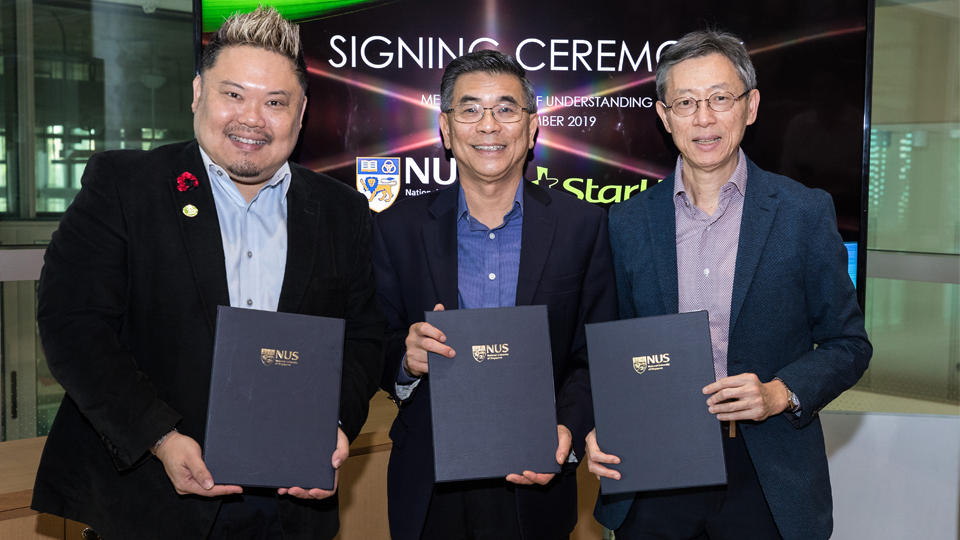The faster and more robust 5G network will enable advanced VR and AI applications for education, research and industry-relevant solutions
The National University of Singapore (NUS) and StarHub have signed a Memorandum of Understanding (MOU) on 12 December 2019 to jointly advance innovation in virtual reality (VR) and artificial intelligence (AI) solutions over StarHub's 5G network in NUS' net-zero energy building located at the School of Design and Environment (SDE). The NUS-StarHub partnership marks NUS' first step towards enabling the adoption of 5G.

Mr Thomas Eugene Chia Fook Kong (left), StarHub Vice President for Enterprise Sales & ICT Engagement; Professor Lam Khee Poh (centre), Dean of NUS School of Design and Environment; and Mr Tommy Hor (right), NUS Chief Information Technology Officer, signed a Memorandum of Understanding on 12 December 2019 to pilot 5G VR and AI Solutions at NUS SDE4 Building, Singapore's first new-build net-zero energy building.
NUS and StarHub will harness the latest 5G technologies to design and test advanced VR and AI solutions. The two partners will also jointly develop use cases to demonstrate the application of 5G capabilities to deliver solutions that will enhance learning, advance cutting-edge research, and address industry needs and challenges.
The research activities will be conducted at a new dedicated 5G laboratory hosted at the NUS SDE4 building, which is Singapore's first newly-built net-zero energy building[1]. The new 5G laboratory is currently under construction and will be operational early next year.
The SDE4 building serves as a living laboratory to explore human-centric approaches to develop solutions that promote integrated sustainable development, and facilitates the test-bedding and development of green building technologies. By leveraging 5G as a key enabling technology, the SDE4 building offers a conducive research environment for the development and trial of practical VR and AI solutions that focus on people-environment wellness within a sustainable ecosystem.
Powering these 5G proof-of-concepts at the SDE4 is StarHub's 5G network, broadcasting on 3.5GHz trial spectrum. 5G offers ultra-reliable low-latency communications and significant improvements in bandwidth performance - the two qualities required for VR and AI solutions to interact seamlessly without lag or signal dropouts.
Mr Tommy Hor, NUS Chief Information Technology Officer, said, "NUS recognises the possibilities offered by the use of 5G technology to sharpen our competitiveness in the fields of education, research and innovation, as well as entrepreneurship. This collaboration with StarHub enables us to seize the opportunities provided by 5G as a key enabling technology, to create practical solutions that will benefit the University and the wider community. This is important and essential in ensuring that NUS continues to thrive in the global digital economy."
Mr Sebastian Tan, Head of 5G Centre of Excellence, StarHub said, "Collaborating with the NUS School of Design and Environment on 5G excites us, as its aspiration to improve lives with technology strongly resonates with ours. With 5G, distance is no barrier when it comes to experiential learning and productivity gets a boost through workflow automation. There is much to be done to realise the full power of 5G, and we are eager to bring together the most advanced technologies and the best brains to co-develop solutions relevant for the people of Singapore."
Professor Lam Khee Poh, Dean of the NUS School of Design and Environment, added, "The School is excited to pilot the experimental use of 5G technology in the SDE4 living laboratory to support human-centric research and advance education initiatives. This is in line with our Well and Green agenda where we endeavour to conduct research on sustainable buildings concurrently with the wellness of occupants in mind, as they interact with the built environment."
NUS SDE and StarHub have started preliminary work on two key projects, among several others, which leverage 5G. These projects are:
(a) Mixed Reality in Education - MILES (Measurement Immersive Learning Engagement System) using 5G for Facilities Management
This education and training initiative utilises 5G AR and VR to conduct immersive and interactive classes by digitalising the education and learning process, through integrating technology into teaching while enhancing learning effectiveness.
Based on current network technology, the number of participants who can join a virtual classroom is limited to just five. Additionally, students need to be present in the same location to access the VR environment which is restricted by hardware and network speed limitations. With 5G, NUS SDE is looking at enabling a class size of 30 students, who can join the virtual classroom simultaneously using next-generation VR equipment. They can even participate remotely, for instance at home, in the library or even in a cafe. The proposed solution will also leverage powerful cloud-based services to eliminate the need for costly hardware such as PCs and servers.
The Department of Building in NUS SDE is exploring the use of VR and AR to deliver classes on measurement, construction technology and facilities management. With the use of VR and AR, students can be immersed in a virtual building environment which will help them understand the fundamentals of measurement in building elements and facilities more effectively.
Please refer to enclosed Annex A for more information.
(b) Building a facade inspection system using AI and drones, powered by 5G
This initiative aims to build a prototype of a real-time, drone-based facade inspection system that will record digital images or videos using a drone-based camera. Subsequently, the recordings will be transmitted over 5G to a remote AI-driven defect detection system for analysis. This capability will transform traditional manual inspections.
Besides ensuring work safety at heights, the use of AI and drones will yield more comprehensive and detailed inspection results, resulting in significant changes in the workflow and operational effectiveness of the building inspection industry.
Please refer to enclosed Annex B for more information.
[1] The net-zero energy building is a building with zero net energy consumption, where the total amount of energy used by the building on an annual basis is equal to the amount of renewable energy generated on the site.





